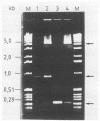Abstract
We used the plasmid vector pGEX-2T for the expression of recombinant subunits of Shiga-like toxin II (SLT-II). The 5' terminus of the genes that code for either the SLT-IIA or SLT-IIB subunits was genetically fused to the 3' terminus of the gene coding for the enzyme glutathione S-transferase, which serves as a carrier in this expression system. The subunit genes were constructed synthetically by polymerase chain reaction, with appropriate restriction sites to permit in-frame downstream insertion of the genes. The resulting plasmids containing the A and B subunit genes were designated pFG1 and pFG2, respectively. Induction of Escherichia coli laboratory strains harboring pFG1 with isopropyl-beta-D-thiogalactopyranoside (IPTG) yielding only small quantities of SLT-IIA fusion proteins. Since IPTG induction was lethal for cells harboring pFG2, we constructed the recombinant plasmid pFG4, which contained a subgenic fragment of slt-IIB but without the 5' signal sequence. With this construct we were able to express very large quantities of a 33.5-kDa fusion protein, which was purified by affinity chromatography on immobilized glutathione and used as an antigen in immunoblot analysis. Rabbit serum against native SLT-II, as well as all of 12 serum samples with high neutralizing activity against SLT-II, reacted with SLT-IIB purified from an E. coli pFG4 expression system, whereas only 3 of 208 human serum samples with low neutralization titers and none of 54 serum samples with no SLT-II-neutralizing capability reacted. Failure of specific reactivity with the SLT-IIB fusion protein in the majority of human serum samples with low neutralizing activity suggests that serum factors other than immunoglobulins may be responsible for neutralizing activity in these cases. The immunoblot assay with recombinant SLT-IIB as the antigen can be recommended for use in a diagnostic setting as a simple and reliable approach to detect specific human serum antibodies to SLT-II.
Full text
PDF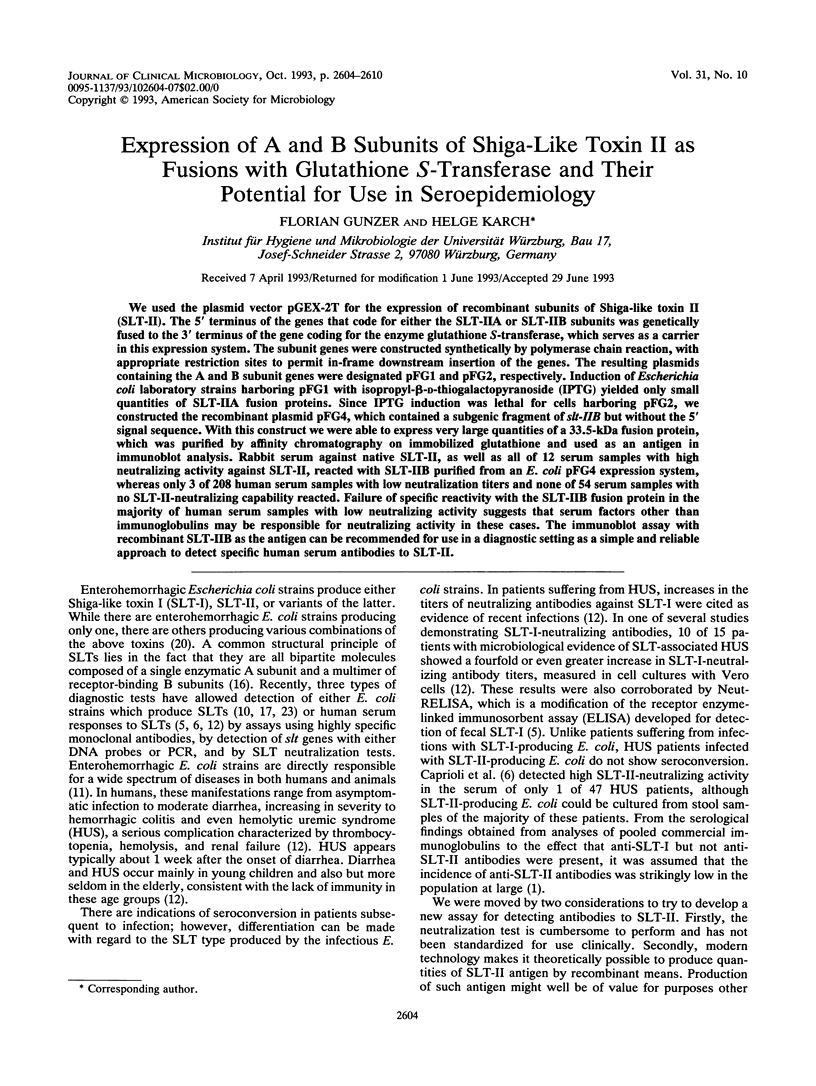
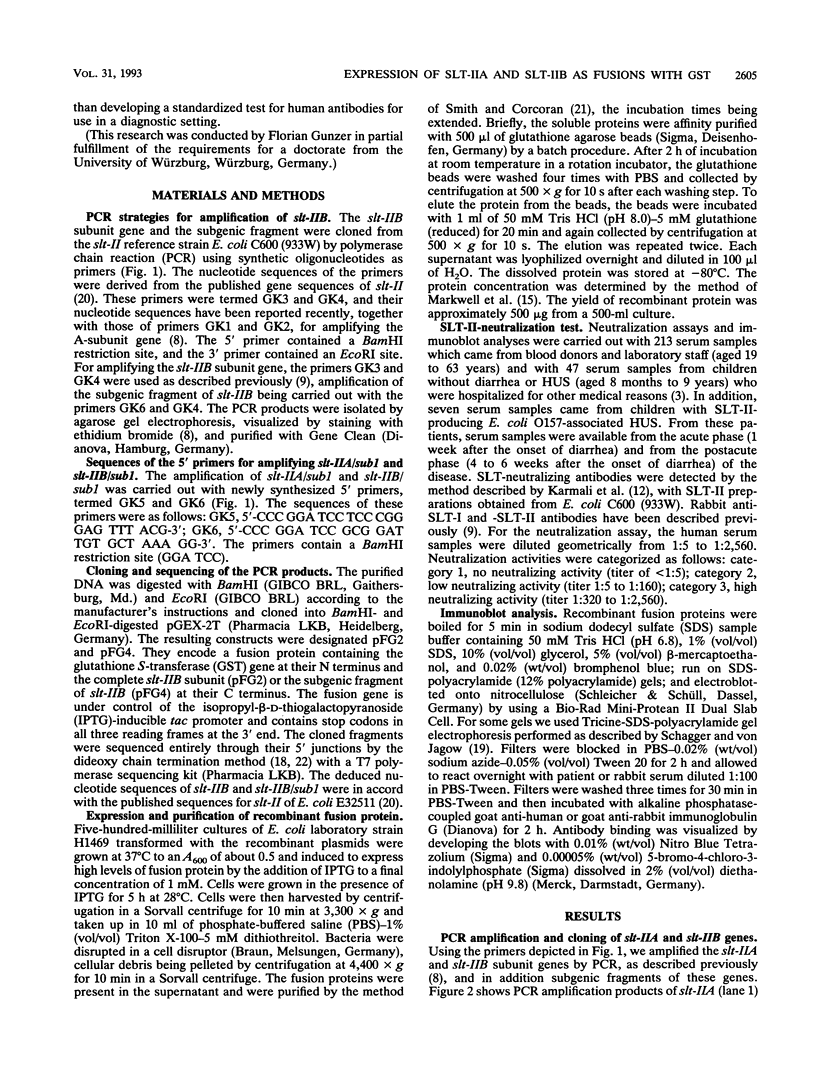
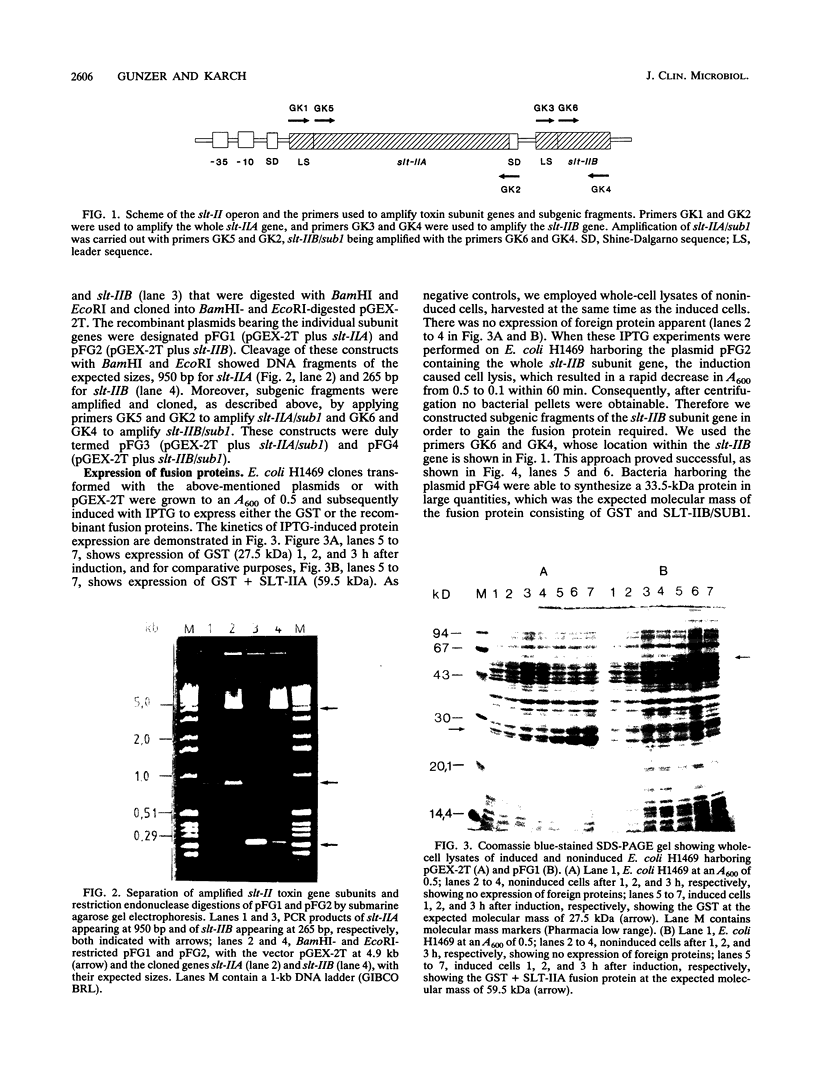
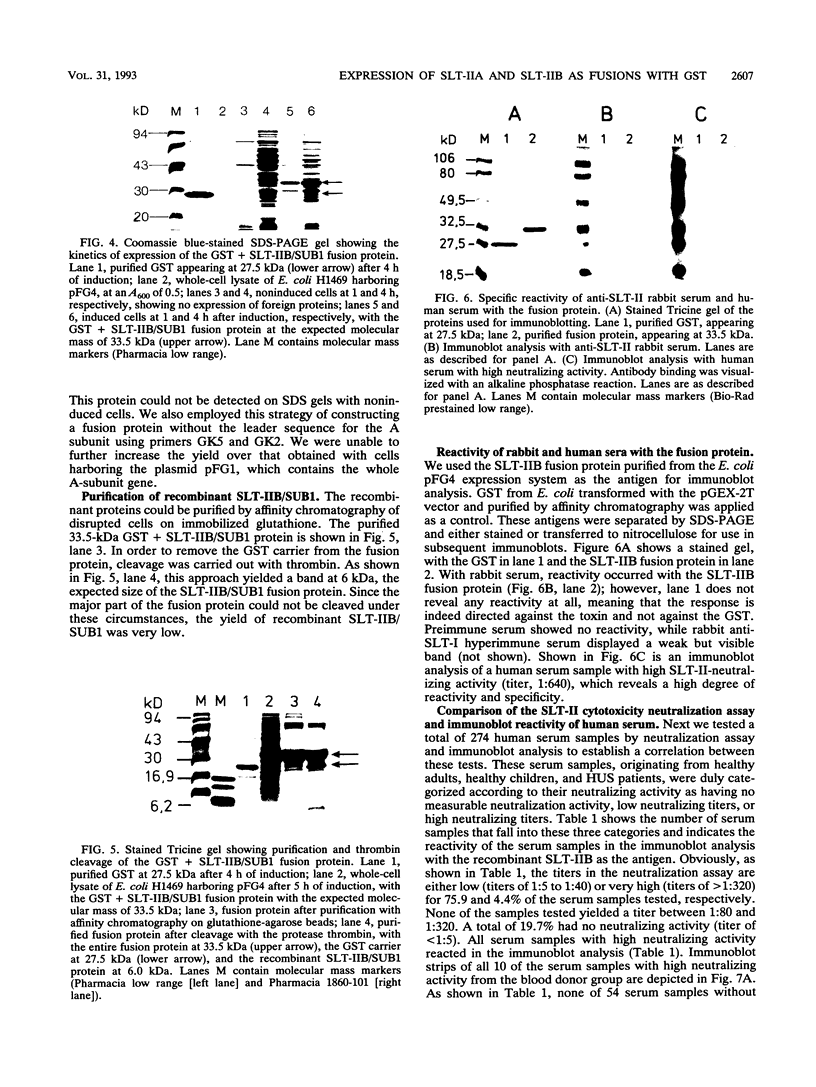
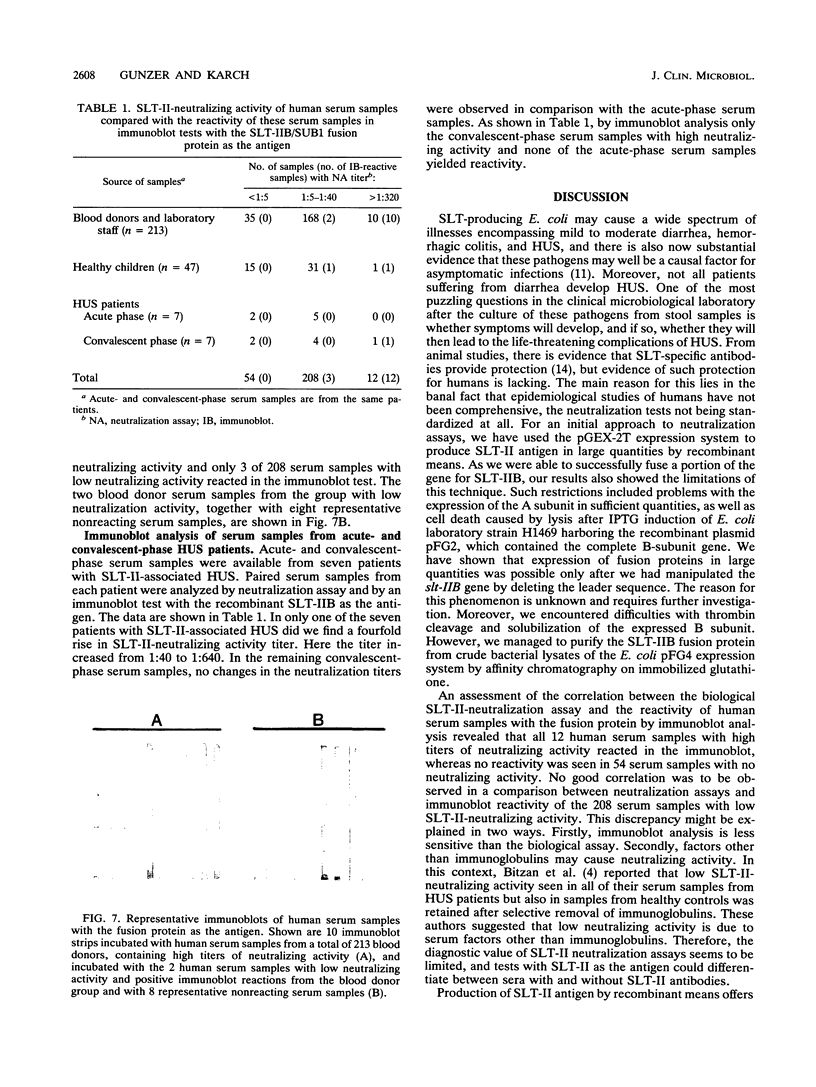
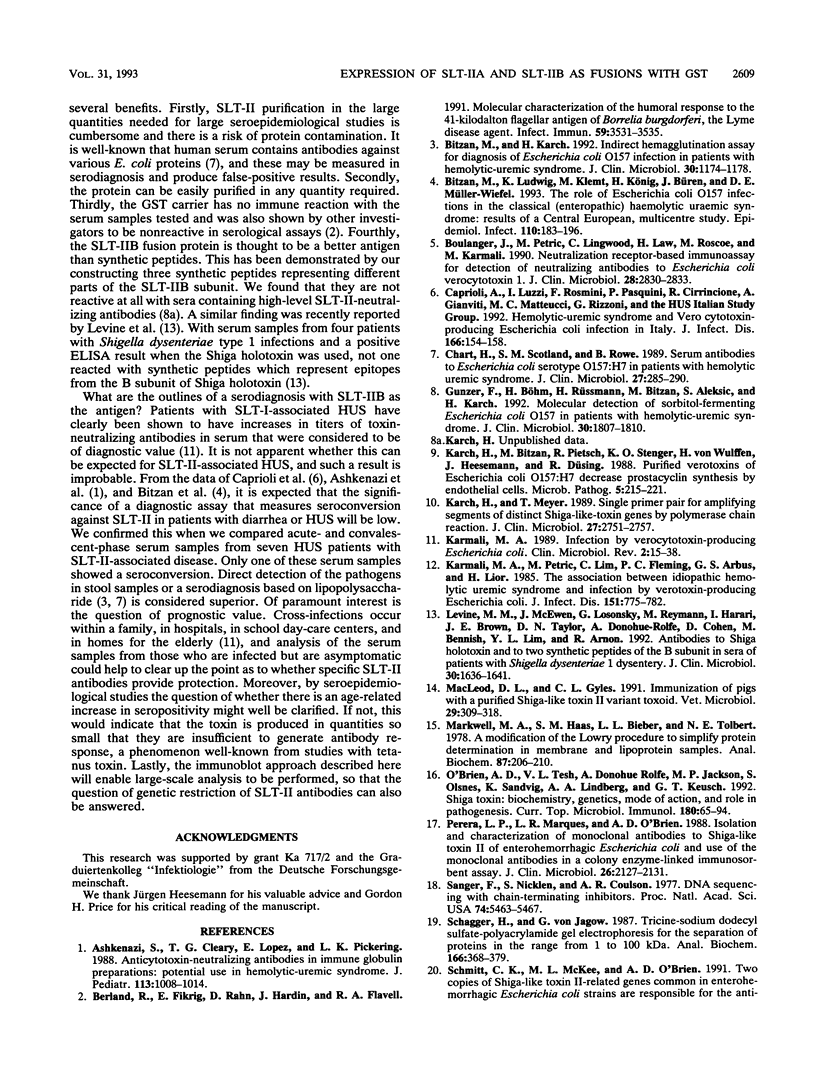
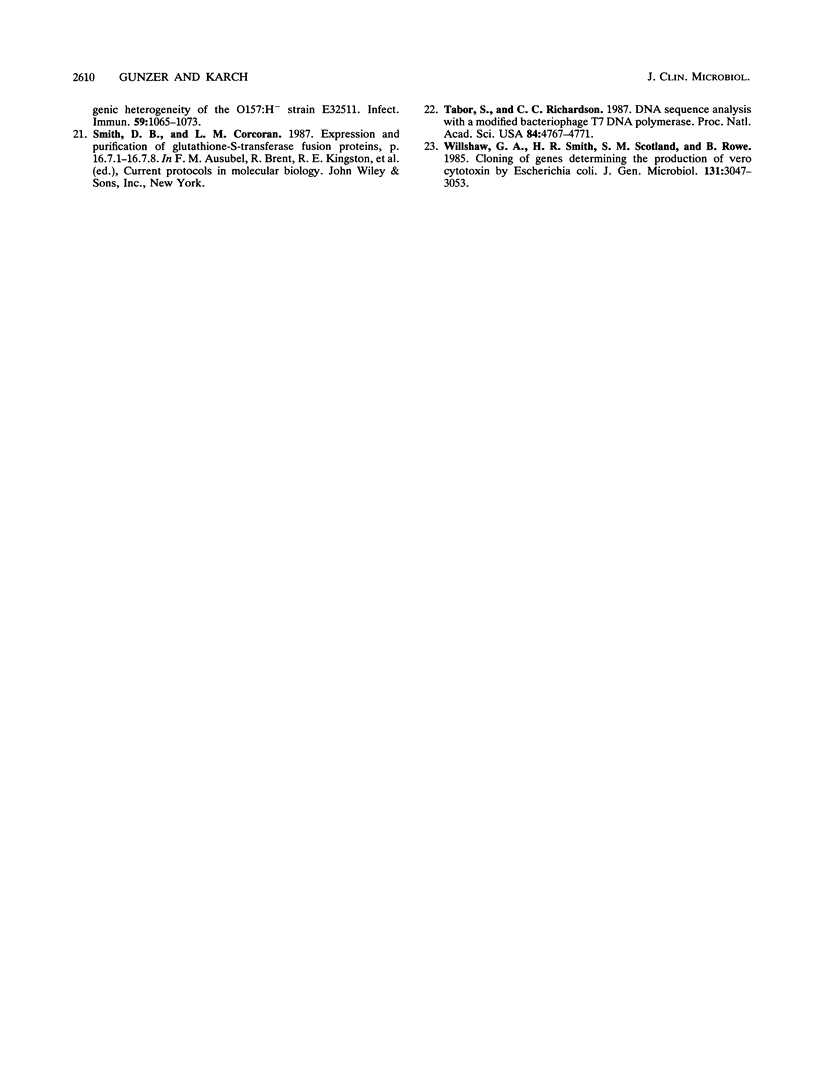
Images in this article
Selected References
These references are in PubMed. This may not be the complete list of references from this article.
- Ashkenazi S., Cleary T. G., Lopez E., Pickering L. K. Anticytotoxin-neutralizing antibodies in immune globulin preparations: potential use in hemolytic-uremic syndrome. J Pediatr. 1988 Dec;113(6):1008–1014. doi: 10.1016/s0022-3476(88)80572-9. [DOI] [PubMed] [Google Scholar]
- Berland R., Fikrig E., Rahn D., Hardin J., Flavell R. A. Molecular characterization of the humoral response to the 41-kilodalton flagellar antigen of Borrelia burgdorferi, the Lyme disease agent. Infect Immun. 1991 Oct;59(10):3531–3535. doi: 10.1128/iai.59.10.3531-3535.1991. [DOI] [PMC free article] [PubMed] [Google Scholar]
- Bitzan M., Karch H. Indirect hemagglutination assay for diagnosis of Escherichia coli O157 infection in patients with hemolytic-uremic syndrome. J Clin Microbiol. 1992 May;30(5):1174–1178. doi: 10.1128/jcm.30.5.1174-1178.1992. [DOI] [PMC free article] [PubMed] [Google Scholar]
- Bitzan M., Ludwig K., Klemt M., König H., Büren J., Müller-Wiefel D. E. The role of Escherichia coli O 157 infections in the classical (enteropathic) haemolytic uraemic syndrome: results of a Central European, multicentre study. Epidemiol Infect. 1993 Apr;110(2):183–196. doi: 10.1017/s0950268800068102. [DOI] [PMC free article] [PubMed] [Google Scholar]
- Boulanger J., Petric M., Lingwood C., Law H., Roscoe M., Karmali M. Neutralization receptor-based immunoassay for detection of neutralizing antibodies to Escherichia coli verocytotoxin 1. J Clin Microbiol. 1990 Dec;28(12):2830–2833. doi: 10.1128/jcm.28.12.2830-2833.1990. [DOI] [PMC free article] [PubMed] [Google Scholar]
- Caprioli A., Luzzi I., Rosmini F., Pasquini P., Cirrincione R., Gianviti A., Matteucci M. C., Rizzoni G. Hemolytic-uremic syndrome and Vero cytotoxin-producing Escherichia coli infection in Italy. The HUS Italian Study Group. J Infect Dis. 1992 Jul;166(1):154–158. doi: 10.1093/infdis/166.1.154. [DOI] [PubMed] [Google Scholar]
- Chart H., Scotland S. M., Rowe B. Serum antibodies to Escherichia coli serotype O157:H7 in patients with hemolytic uremic syndrome. J Clin Microbiol. 1989 Feb;27(2):285–290. doi: 10.1128/jcm.27.2.285-290.1989. [DOI] [PMC free article] [PubMed] [Google Scholar]
- Gunzer F., Böhm H., Rüssmann H., Bitzan M., Aleksic S., Karch H. Molecular detection of sorbitol-fermenting Escherichia coli O157 in patients with hemolytic-uremic syndrome. J Clin Microbiol. 1992 Jul;30(7):1807–1810. doi: 10.1128/jcm.30.7.1807-1810.1992. [DOI] [PMC free article] [PubMed] [Google Scholar]
- Karch H., Bitzan M., Pietsch R., Stenger K. O., von Wulffen H., Heesemann J., Düsing R. Purified verotoxins of Escherichia coli O157:H7 decrease prostacyclin synthesis by endothelial cells. Microb Pathog. 1988 Sep;5(3):215–221. doi: 10.1016/0882-4010(88)90024-1. [DOI] [PubMed] [Google Scholar]
- Karch H., Meyer T. Single primer pair for amplifying segments of distinct Shiga-like-toxin genes by polymerase chain reaction. J Clin Microbiol. 1989 Dec;27(12):2751–2757. doi: 10.1128/jcm.27.12.2751-2757.1989. [DOI] [PMC free article] [PubMed] [Google Scholar]
- Karmali M. A. Infection by verocytotoxin-producing Escherichia coli. Clin Microbiol Rev. 1989 Jan;2(1):15–38. doi: 10.1128/cmr.2.1.15. [DOI] [PMC free article] [PubMed] [Google Scholar]
- Karmali M. A., Petric M., Lim C., Fleming P. C., Arbus G. S., Lior H. The association between idiopathic hemolytic uremic syndrome and infection by verotoxin-producing Escherichia coli. J Infect Dis. 1985 May;151(5):775–782. doi: 10.1093/infdis/151.5.775. [DOI] [PubMed] [Google Scholar]
- Levine M. M., McEwen J., Losonsky G., Reymann M., Harari I., Brown J. E., Taylor D. N., Donohue-Rolfe A., Cohen D., Bennish M. Antibodies to shiga holotoxin and to two synthetic peptides of the B subunit in sera of patients with Shigella dysenteriae 1 dysentery. J Clin Microbiol. 1992 Jul;30(7):1636–1641. doi: 10.1128/jcm.30.7.1636-1641.1992. [DOI] [PMC free article] [PubMed] [Google Scholar]
- MacLeod D. L., Gyles C. L. Immunization of pigs with a purified Shiga-like toxin II variant toxoid. Vet Microbiol. 1991 Nov;29(3-4):309–318. doi: 10.1016/0378-1135(91)90138-6. [DOI] [PubMed] [Google Scholar]
- Markwell M. A., Haas S. M., Bieber L. L., Tolbert N. E. A modification of the Lowry procedure to simplify protein determination in membrane and lipoprotein samples. Anal Biochem. 1978 Jun 15;87(1):206–210. doi: 10.1016/0003-2697(78)90586-9. [DOI] [PubMed] [Google Scholar]
- O'Brien A. D., Tesh V. L., Donohue-Rolfe A., Jackson M. P., Olsnes S., Sandvig K., Lindberg A. A., Keusch G. T. Shiga toxin: biochemistry, genetics, mode of action, and role in pathogenesis. Curr Top Microbiol Immunol. 1992;180:65–94. doi: 10.1007/978-3-642-77238-2_4. [DOI] [PubMed] [Google Scholar]
- Perera L. P., Marques L. R., O'Brien A. D. Isolation and characterization of monoclonal antibodies to Shiga-like toxin II of enterohemorrhagic Escherichia coli and use of the monoclonal antibodies in a colony enzyme-linked immunosorbent assay. J Clin Microbiol. 1988 Oct;26(10):2127–2131. doi: 10.1128/jcm.26.10.2127-2131.1988. [DOI] [PMC free article] [PubMed] [Google Scholar]
- Sanger F., Nicklen S., Coulson A. R. DNA sequencing with chain-terminating inhibitors. Proc Natl Acad Sci U S A. 1977 Dec;74(12):5463–5467. doi: 10.1073/pnas.74.12.5463. [DOI] [PMC free article] [PubMed] [Google Scholar]
- Schägger H., von Jagow G. Tricine-sodium dodecyl sulfate-polyacrylamide gel electrophoresis for the separation of proteins in the range from 1 to 100 kDa. Anal Biochem. 1987 Nov 1;166(2):368–379. doi: 10.1016/0003-2697(87)90587-2. [DOI] [PubMed] [Google Scholar]
- Tabor S., Richardson C. C. DNA sequence analysis with a modified bacteriophage T7 DNA polymerase. Proc Natl Acad Sci U S A. 1987 Jul;84(14):4767–4771. doi: 10.1073/pnas.84.14.4767. [DOI] [PMC free article] [PubMed] [Google Scholar]
- Willshaw G. A., Smith H. R., Scotland S. M., Rowe B. Cloning of genes determining the production of vero cytotoxin by Escherichia coli. J Gen Microbiol. 1985 Nov;131(11):3047–3053. doi: 10.1099/00221287-131-11-3047. [DOI] [PubMed] [Google Scholar]




